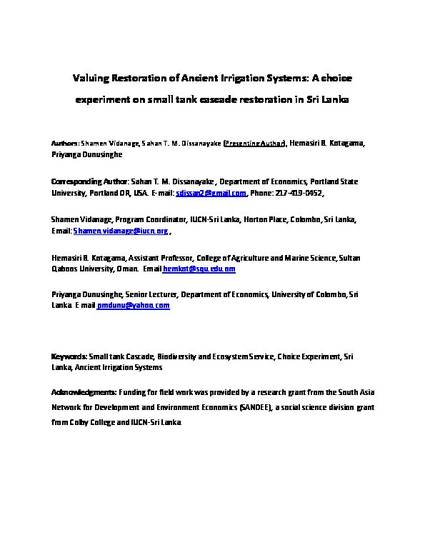
Other
Valuing Restoration of Ancient Irrigation Systems: A choice experiment on small tank cascade restoration in Sri Lanka
(2018)
Abstract
Cascading Tank Systems are an ancient irrigation system in South Asia developed to support agriculture and population expansion to arid areas by collecting rainwater during the wet season for use in the dry season. The tanks are created by blocking the natural drainage system in a watershed using earth bunds in selected locations to enable storing of water and forming a series of tanks that allows the water to cascade from tank to tank. This man-made socio-ecological system, which has parallels to the Japanese land use system of Satoyama, was established and fostered by ruling kings and is regarded as an early application of Integrated Water Resources Management (IWRM) given the use of landscape level planning and water and soil conservation aspects.
The cascading tank system in Sri Lanka, which has a history of over 2,000 years, captures Northeast monsoon rains and allows for agriculture in the dry season, prevents floods, and increases ground water recharge. There are approximately 15,000 small tanks and 13,000 anicuts, feeding an extent of about 200,000 hectares (25% of the total irrigable area of the country) in Sri Lanka. Over the last few centuries the structure of the cascade tanks and the hydrologic system connecting the tanks have slowly deteriorated due to lack of maintenance and the disappearance of the traditional community institutions that were responsible for the cascade tank system. Further, many villagers and famers are no longer aware of the inter-connectedness of the tanks or the need to maintain ecosystem structures that were built to naturally maintain the tank system (i.e. use of the landscape and trees and shrubs to filter the water, reduce erosion, and reduce evaporation).
In this research we use a choice experiment survey, conducted in a cascade tank system in Anuradhapura, Sri Lanka, to understand rural villagers’ preferences and the willingness to pay/contribute to restore cascading tanks systems. We supplement the study with a sample of urban residents to understand how the preferences vary between urban and rural residents.
Results indicate that respondents value the availability of water for agriculture, water for household use, the cascade ecosystem health, and biodiversity. We then generate the marginal and total WTP for cascade restoration and conduct a cost benefit analysis using the choice experiment results as perceived benefits and find the restoration of STC is feasible a with 17% IRR and 1.47 BC ratio taking 20 years as the life of the project. In addition we contribute to the choice experiment methodologic literature by comparing data gathering methods (group information sessions vs. individual surveys) and forms of payment (labor vs cash). We are currently analysing this data and will have those results by May 2018 in time for the 2018 WCERE.
Disciplines
Publication Date
2018
Citation Information
Sahan T.M. Dissanayake. "Valuing Restoration of Ancient Irrigation Systems: A choice experiment on small tank cascade restoration in Sri Lanka" (2018) Available at: http://works.bepress.com/sahan-dissanayake/28/
Creative Commons license

This work is licensed under a Creative Commons CC_BY-ND International License.
